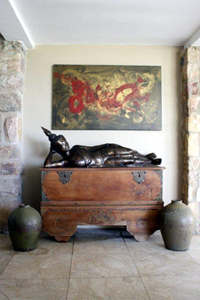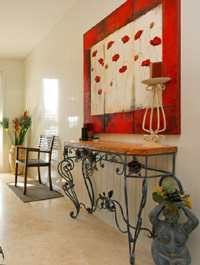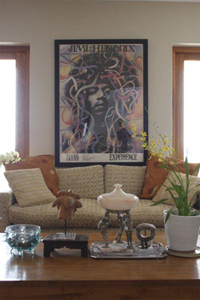A picture says a thousand words
Pictures add colour and interest to your walls, and amassing a fine display is one of the oldest and most popular ways of turning your house into a home.
The range of choice is so wide that you are sure to find plenty that will suit your décor. Personal taste and flair must pay an important role when it comes to choosing and arranging pictures, but there are some points worth bearing in mind. One of the most important things to remember is to choose a picture that really appeals to you, rather than one that just suits your décor scheme.
The art of display
Carefully consider the size of the room and its décor before choosing pictures for it. For example, a plain background will be fine for most pictures, but if you have patterned wallpaper or a particularly dark coloured wall, it might be better to give the pictures a larger coloured mount to ensure that it stands out.
It is also important to bear in mind the shape and size of any furniture positioned beneath the proposed display and avoid choosing pictures that will look out of balance with their surrounds. If you are buying art as an investment, then oils, watercolours, certain photographs and limited edition prints are all likely to increase in value over time, especially if the artist or image gains in popularity. Having said this however, even if you are investing your money wisely, it is still important that you exercise personal judgement in selecting pictures that you love and want to live with.
Oil paintings
When considering buying pictures for their own homes, many people rule out oil paintings as the prerogative of museums and millionaires. Yet, in reality, oil paintings are not beyond the reach of the ordinary person, and have a very special appeal of their own.
Young artists are usually delighted to sell their artwork at quite modest prices, and one can often pick up the works of lesser known artists of the past for a steal. Oil paintings range from miniatures to vast mural-like canvases, and from realistic interpretations to very abstract works of art.
A bold abstract can make a striking addition to any modern interior, whereas a naturalistic still-life will complement any traditional room. Alternatively, you can achieve spectacular results by breaking away from the obvious choice – an old fashioned oil portrait for example, would offer a striking contrast in a sleek contemporary living room.
Watercolours
Watercolours tend to be smaller than oil paintings, and their use of subject is not as great. Because of the popularity of this medium with amateur artists, past and present, watercolours are widely available. Older watercolours, often fauna and flora studies or picturesque landscape scenes, fit in delightfully with cottage-, nautical- or rustic-style décor.
The benefit of watercolours is that since the pictures generally take less time to execute, and the paint is far less costly than other mediums, the finished pieces are usually less expensive, while still remaining unique.
Reproductions
Reproductions are not necessarily second best to originals: there is a strong argument for the benefit of viewing the work of the great artists of our time. When buying a reproduction, it is important to check the quality of the printing and the paper. As a general rule of thumb, the more expensive the print; the finer the paper and the better the printing quality, and so the colours will be more true to the original artwork. Some reproductions of oil paintings are even printed on textured paper to resemble canvas for a more authentic look.
Prints
Both old and modern prints are a fairly inexpensive form of decoration. They are made by a variety of techniques and cover a huge range of subjects, from old fashioned hunting scenes, to cutting-edge abstract designs. Modern prints are available from art dealers and galleries, and some are made in limited editions.
Old prints can be obtained second-hand, and if it is a limited edition and in a good condition, and it is a print of a popular artist, then they can be a very good investment. Alternatively, you can purchase prints for a very reasonable price, and can set the tone of a room by investing in several prints of related subjects for a more co-ordinated look.
Photographs
When using photographs for decoration, bear in mind the difference between simple family snapshots and photographic images that you regard as the equivalent of a painting. You can make an eye-catching display of your family history, or showcase artistic images of the world around us.
If you have one shot that you are particularly keen on, you can have this shot enlarged, and even get it printed directly onto a canvas. Old photographs have always held a particular fascination – those by pioneer photographers or of famous characters from history have become collector's items and are priced accordingly.
Posters
Modern posters are available in every conceivable design and can even be specially designed to suit a particular décor scheme. The range of subjects is enormous and includes reproductions of old advertising posters, as well as specially commissioned modern designs. As they are mass-produced, they are very inexpensive, and this makes them a particularly good choice if you tend to grow bored very quickly with your décor schemes.
An obvious choice for posters, would be for a child's or a teenager's room, but of course, they can also be used very effectively in other rooms as well. For example, framed soap and cosmetic advertisements from the 1920s can offer an inexpensive, yet authentic touch to a Victorian bathroom, or old rock posters can offer an otherwise conservative lounge an edgy and modern feel.
Frames
Selecting the right frame for a picture will greatly influence the final effect. Choose one that is appropriate to the picture itself and to the décor scheme in which it is to be featured. Keep the size of the picture in mind as well, so that a small picture for example, is not dwarfed by an oversized frame. If your art is particularly valuable or is something that you absolutely adore, it is worthwhile to get it professionally framed – this will not only give it the best aesthetic appearance, but will also serve to best preserve the piece of art as well.





